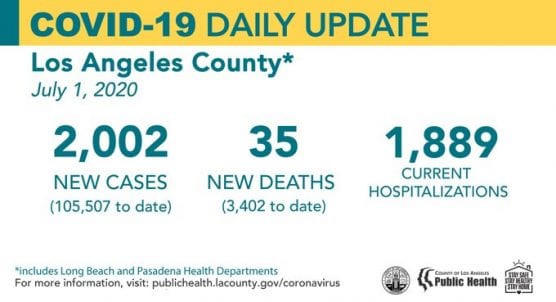Continuing to see steep increases in community spread of COVID-19, the Los Angeles County Department of Public Health on Wednesday confirmed 2,002 new cases of COVID-19 and 35 new deaths due to the virus countywide, as Henry Mayo Newhall Hospital reported its 14 fatality, bringing the Santa Clarita Valley’s toll to 32 people.
A total of 3,206 confirmed COVID-19 cases have been reported in the Santa Clarita Valley to date, 21 more cases than reported Tuesday.
The SCV total includes 1,207 confirmed cases in the city of Santa Clarita.
According to Public Health records, of the 32 SCV residents who have died of the virus to date, 24 resided in the city of Santa Clarita, 2 in Acton, 2 in Castaic, 1 in Val Verde, 1 in unincorporated Valencia, 1 in unincorporated Bouquet Canyon, and 1 in a community not yet named.
Countywide, Public Health has reported 105,507 positive cases of COVID-19 and a total of 3,402 deaths to date. Ninety-three percent of people who died had underlying health conditions.
There are 1,889 people with confirmed COVID-19 cases currently hospitalized, 27% of them in the ICU and 18% on ventilators.
This is the largest number of people hospitalized since early May.

There are 2,002 new cases of COVID-19. This is the fourth consecutive day of new cases exceeding 2,000. And Wednesday’s number is missing lab reports from one of the larger labs.
“We are thinking every day of the many families who have lost loved ones to COVID-19. Our hearts go out to you, and we are so sorry for your loss,” said Barbara Ferrer, PhD, MPH, MEd, director of L.A. County Public Health.

Statewide, as of June 30, the California Department of Public Health has confirmed a total of 232,657 cases (5,898 for June 30 and another 3,842 results received) and 6,090 deaths (up 110 from June 29) from COVID-19.
Currently, there are 5,196 confirmed hospitalizations and 1,617 ICU hospitalizations in California.
Due to California’s dramatic increase in testing capacity and growing demand for tests, labs and local public health departments are processing and verifying more test results than ever. As a result, the reporting of some test results has been delayed.
CDPH is processing delayed test results and updating California’s case counts. To ensure the data accurately reflects how COVID-19 is impacting our communities, previously reported case numbers may sometimes be updated retroactively. The graph below shows how cases have been adjusted in recent days.

Santa Clarita Valley Wednesday Update
Of the 3,206 cases reported to Public Health for the SCV to date, the community breakdown is as follows:
City of Santa Clarita: 1,207
Castaic: 1,791 (includes Pitchess Detention Center and North County Correctional Facility*)
Stevenson Ranch: 66
Canyon Country (unincorporated portion): 47
Val Verde: 29
Acton: 22
Valencia (unincorporated portion west of I-5): 13
Agua Dulce: 13
Saugus (unincorporated portion): 6
Elizabeth Lake: 4
Newhall (Unincorporated portion): 3
Bouquet Canyon: 1
Lake Hughes: 1
*Note: The county is unable to break out separate numbers for Castaic and PDC/NCCF because the county uses geotagging software that cannot be changed at this time, according to officials. Click here for the LASD COVID-19 dashboard.

Henry Mayo Wednesday Update
Henry Mayo Newhall Hospital reported its 14th COVID-related death on Wednesday, July 1, who died over the past weekend, according to hospital spokesman Patrick Moody, who could not disclose the decedent’s city of residence due to privacy regulations.
The hospital is now releasing numbers on a weekly basis (Wednesdays) unless there is a drastic change in the number of cases or a death has been confirmed, Moody said.
As of Wednesday, July 1, of the 3,273 persons tested at Henry Mayo to date, 349 tested positive, 3,214 were negative, 151 were pending and 19 patients were hospitalized in a dedicated unit receiving ICU-level care, six more than reported last Wednesday. A total of 110 COVID-19 patients have been discharged so far.
Discrepancies in the testing numbers are due to some patients being tested multiple times. “Often a single patient is tested more than once,” Moody said.
L.A. County Demographics: Age, Race & Ethnicity

Twenty-one people who died were over 65 years old, six people who died were between 41 and 65 years old, and four people who died are between 18 and 40 years old. Thirty-one people had underlying health conditions including 25 people over 65 years old and six people between 41 to 65 years old.
Two deaths were reported by the city of Long Beach and two deaths were reported by the city of Pasadena.
Of those who died, information about race and ethnicity is available for 3,158 people (99 percent of the cases reported by Public Health); 43% of deaths occurred among Latino/Latinx residents, 27% among White residents, 17% among Asian residents, 11% among African American/Black residents, less than 1% among Native Hawaiian/Pacific Islander residents and 1% among residents identifying with other races.
Upon further investigation, 24 cases and two deaths reported earlier were not L.A. County residents.

Beaches Closed; Fireworks Displays Kiboshed
Earlier this week a Health Officer Order was issued that closes L.A. County beaches from July 3 through July 6 at 5 a.m. to prevent crowded situations that could result in more spread of COVID-19.
All public beaches, piers, public beach parking lots, beach bike paths that traverse that sanded portion of the beach, and beach access points will be temporarily closed to the public.
The order also prohibits fireworks displays.
“I know these closures are frustrating and it is heartbreaking to think we are losing ground,” Ferrer said. “These immediate actions give us a chance to regain control over the increased spread. With steep increases in cases and hospitalizations, it is important to act now to prevent as many future cases, hospitalizations and deaths as we can.”

Best Protections
The best protection against COVID-19 continues to be to wash your hands frequently, avoid touching your eyes, nose, and mouth with unwashed hands, self-isolate if you are sick, practice physical distancing, and wear a clean face covering when in contact with others from outside your household.
Everyone must always wear a face covering securely over your nose and mouth and keep six feet apart from others not in your household when out and about. Businesses must continue to follow Public Health directives. It is the collective responsibility shared between everyone including businesses and residents to slow the spread of COVID-19 to prevent an overwhelming surge of COVID-19 cases at healthcare facilities and save lives.
The Reopening Protocols, COVID-19 Surveillance Interactive Dashboard, Roadmap to Recovery, Recovery Dashboard, and additional things you can do to protect yourself, your family and your community are on the Public Health website, www.publichealth.lacounty.gov.

California Demographics
California Public Health is committed to health equity and collecting more detailed racial and ethnic data that will provide additional understanding for determining future action.
Health outcomes are affected by forces including structural racism, poverty and the disproportionate prevalence of underlying conditions such as asthma and heart disease among Latinos and African American Californians. Only by looking at the full picture can we understand how to ensure the best outcomes for all Californians.
The differences in health outcomes related to COVID-19 are most stark in COVID-19 deaths. We have nearly complete data on race and ethnicity for COVID-19 deaths, and we are seeing the following trends. Overall, for adults 18 and older, Latinos, African Americans and Native Hawaiians and Pacific Islanders are dying at disproportionately higher levels.
The proportion of COVID-19 deaths in African Americans is more than one-and-a-half times their population representation across all adult age categories. For Native Hawaiians and Pacific Islanders, overall numbers are low, but almost double between the proportion of COVID-19 deaths and their population representation.
More males are dying from COVID-19 than females, in line with national trends.
More information is available at COVID-19 Race and Ethnicity Data.
More on Testing in California
As testing capacity continues to increase across the state, the California Department of Public Health is working to expand access to COVID-19 testing. Testing should be used for medical evaluation of persons with symptoms of COVID-19 as well as for efforts by public health agencies and essential employers to prevent and control the spread of COVID-19.
These numbers include data from commercial, private and academic labs, including Quest, LabCorp, Kaiser, University of California and Stanford, and the the 25 state and county health labs currently testing.
More than 85 community testing sites also offer free, confidential testing: Find a COVID-19 Testing Site.

Protect Yourself and Your Family
Every person has a role to play. Protecting yourself and your family comes down to common sense:
* Staying home except for essential needs/activities following local and state public health guidelines when patronizing approved businesses. To the extent that sectors are re-opened, Californians may leave their homes to work at, patronize, or otherwise engage with those businesses, establishments or activities.
* Practicing social distancing.
* Wearing a cloth face mask when out in public.
* Washing hands with soap and water for a minimum of 20 seconds.
* Avoiding touching eyes, nose or mouth with unwashed hands.
* Covering a cough or sneeze with your sleeve, or disposable tissue. Wash your hands afterward.
* Avoiding close contact with people who are sick.
* Staying away from work, school or other people if you become sick with respiratory symptoms like fever and cough.
* Following guidance from public health officials.

What to Do if You Think You’re Sick
Call ahead: If you are experiencing symptoms of COVID-19 (fever, cough or shortness of breath), call your health care provider before seeking medical care so that appropriate precautions can be taken. More than 85 community testing sites also offer free, confidential testing: Find a COVID-19 Testing Site.
California COVID-19 Data Portal
The state has launched a new, user-friendly data portal at COVID-19 Statewide Update that tracks COVID-19 cases statewide and by county, gender, age and ethnicity. The portal also outlines statewide hospitalizations and testing efforts. The data presented on the portal will be updated daily and will include additional information as it is available.
For more information about what Californians can do to prevent the spread of COVID-19, visit Coronavirus (COVID-19) in California.
California continues to issue guidance on preparing and protecting California from COVID-19. Consolidated guidance is available on the California Department of Public Health’s Guidance webpage.

Always check with trusted sources for the latest accurate information about novel coronavirus:
– Los Angeles County Department of Public Health
– California Department of Public Health
– Centers for Disease Control and Prevention
– Spanish
– World Health Organization
L.A. County residents can also call 2-1-1.
Like this:
Like Loading...
Related





 Tweet This
Tweet This Facebook
Facebook Digg This
Digg This Bookmark
Bookmark Stumble
Stumble RSS
RSS





































REAL NAMES ONLY: All posters must use their real individual or business name. This applies equally to Twitter account holders who use a nickname.
0 Comments
You can be the first one to leave a comment.